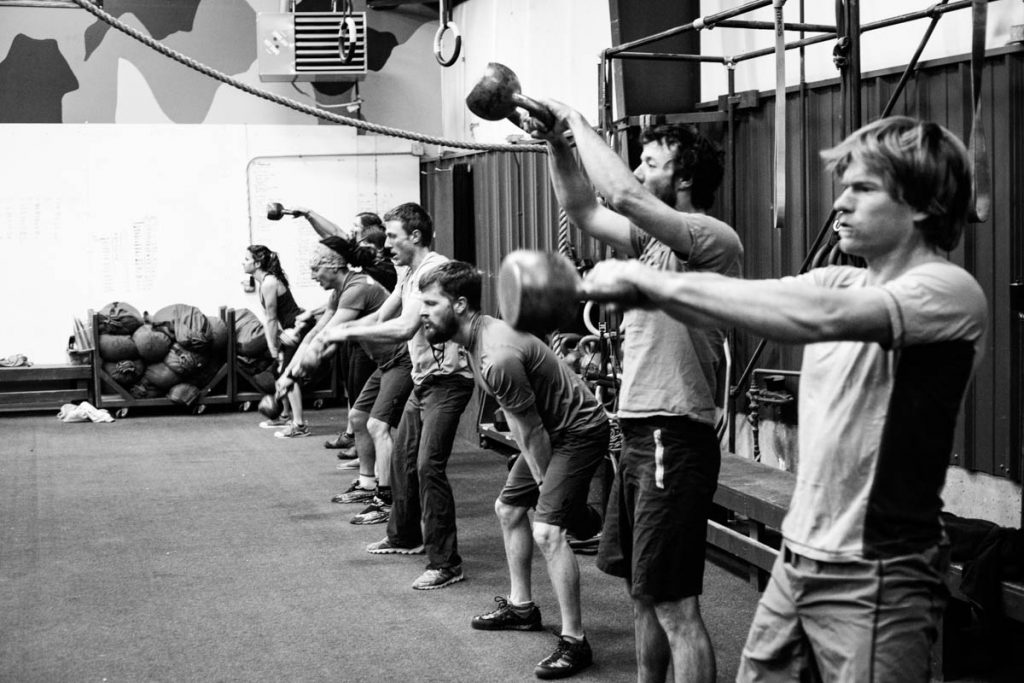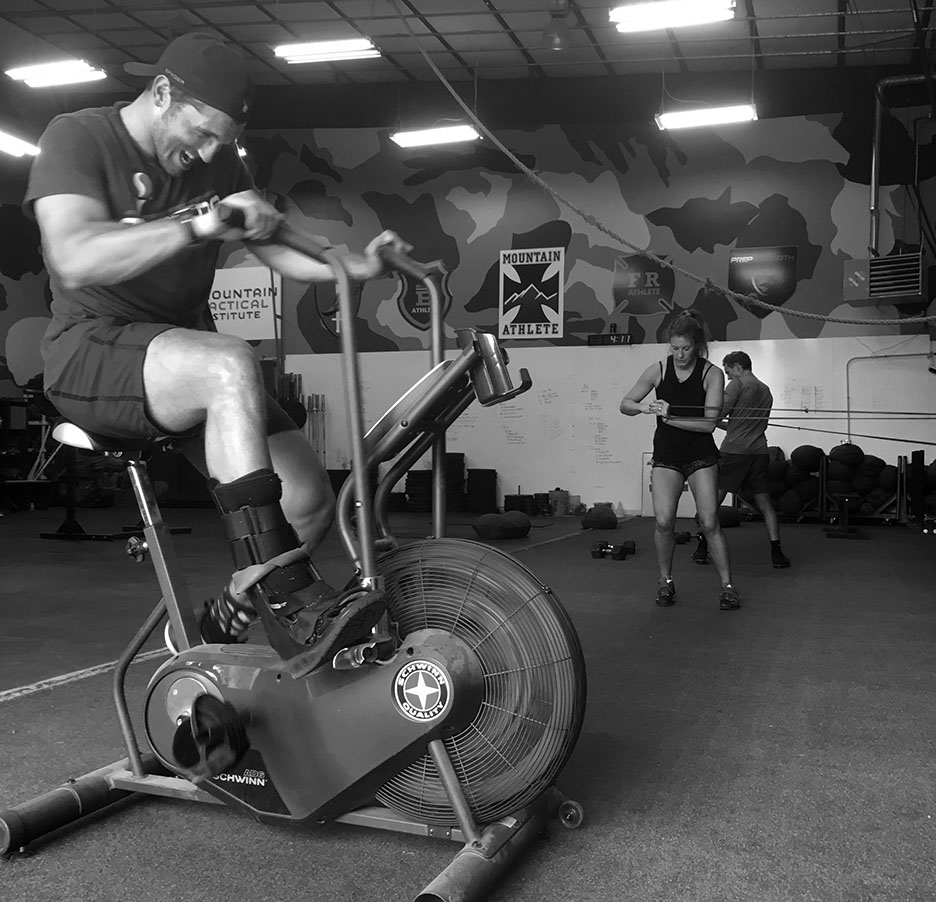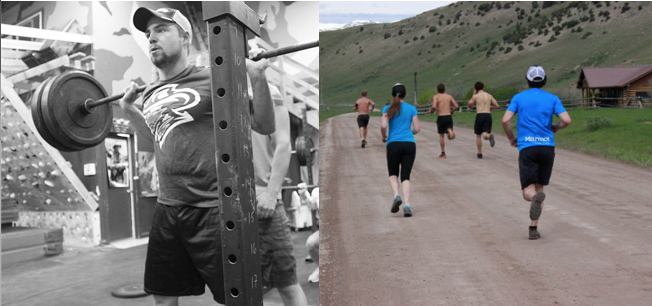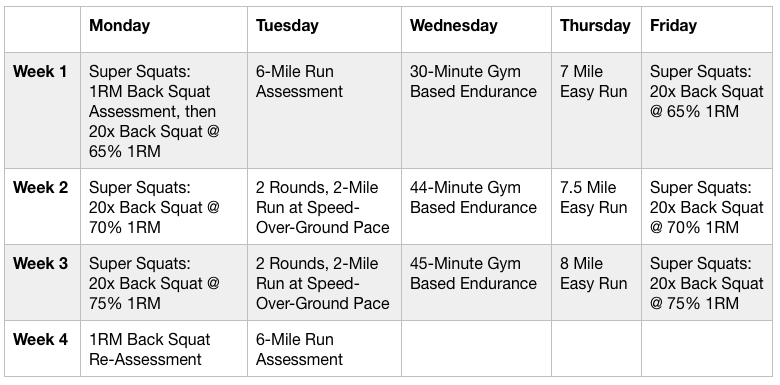QUESTION
I’m a scout platoon leader and currently deployed. I’m looking for a good program to maintain 1000 lb club while running a sub 13:00 minute 2 mile.
My current lifts are:
Bench: 315
Squat: 350
Deadlift: 410
I can run about a 14:00 2 mile. Back in the early LT days I ran about a 12:00 2 mile. I didn’t do much maxing out in those days. I’m curious what you would recommend to augment a big 24 progression for strength while running enough to improve run times without over exerting or just leading to injury. Down the road I’ll be training to compete to go work for Ranger Training Battalion and have to get my 5 mile time down as well.
What would you recommend?
ANSWER
I don’t have the perfect plan for you with those specific lifts.
One option would be
Waylon, which deploys strength density training for the Power Clean, Box Squat and Push Press and a 1.5 mile run assessment with follow-on 800m repeats. You could change the lifts in this plan to the bench, dead and back squat and complete it as prescribed.
– Rob
QUESTION
You all have so many fine programs for a person to choose from. But what if an individual wanted to engage in Commercial Diving as a way of life. Do you have a program for that or is there a way a program can be made. Just courious
ANSWER
Not specifically. From what we do have I’d recommend the Combat Diver Qualification Course Training Plan. It’s designed for Green Berets going to dive school.
– Rob
QUESTION
I’m writing because I need some help finding the right training plan for my goals. The Peak Bagger Training Plan seems like a good choice, but I wanted to confirm with you.
Goal
Climb in the Alps this season (End of June to Early in July). I haven’t figured out all of the logistics yet, but I’m considering starting in the Bernese Alps with Jungfrau (13,668 ft) and Mönch (13,468 ft) and then moving on to more technical mountains like the Matterhorn (14,692 ft).
Overall, the mountains I plan to do will consist of some if not all of the following: Long and steep approaches under load (25-35 lbs), scrambling, glacier travel, cat walking, and some rock climbing.
Current Fitness Level
I haven’t done a fitness assessment yet, but I just climbed Mount Shasta via Casaval Ridge (2 days) last week and Mount Whitney via Mountaineers Route (2 days) 3 week ago. Both of those mountains were done with a 35 lb pack for the approach and a 10-15 lb pack for the summit push. I also boulder and sports climb (mostly indoors), although I haven’t been doing much of it in the past month.
Training
My training consisted of running at different heart rate zones, doing step-ups under a 25lb load, doing mini-leg blasters, and upper body strength exercises like dips, push-ups and pull ups. Please let me know if you would like me to be more specific
I hope this information is helpful.
I look forward to hearing from you.
ANSWER
You’ve got just 7 weeks until June 24. I’d recommend the
Peak Bagger Training Plan – since you say rock climbing won’t be a big focus of your work in the Alps. Peak Bagger is a 7-week plan, and fits perfect.
– Rob
QUESTION
Quick question. Should I be using grips to deadlift more weight as it’s always my grip that fails first or should I just increase weight as my grip gets stronger?
ANSWER
No grips, but do use a reverse grip – one hand palm toward your face, one hand palm away. Doesn’t matter what hand is which.
This will help.
– Rob
QUESTION
First off, I’m a new subscriber and wanted to thank you for all your hard work putting together such extensive and well thought out training programs. I know a lot of folks who have benefitted from your programs in the past and speak very highly about your methodology.
I’m about to start the SFRE prep program, but I’m in a position where I’m roughly 4 months out from the event, meaning I could potentially run the program twice before I try out. I’m hoping I can pick your brain about how you might structure the training differently for someone in such a position. I was thinking about running the program one time through with scaled down weight/distance/reps/etc, but am not sure the best way to determine how much I should scale (e.g. 50% of the recommended workout, 75% etc). I imagine it’s mostly takes trial and error to find the right amount to push, but I wanted to consult you first out of respect for you and your program. I’d hate to think I’m being clever if in actuality, I’m butchering it.
Also, I noticed you recommend the Garmin Forerunner 15 for measuring distance and speed. Is that still your recommendation nowadays? I’m interested to hear why you prefer that over some of the more recent models.
Thank you very much for all of your help and I look forward to hearing from you soon.
ANSWER
4 months = 16 weeks.
Many parts of the
SFRE plan are assessment based, so cutting a percentage of the sessions may or may not work. But you could try – say, do 75% of the prescribed rounds for each circuit.
Better would be to complete the first six weeks of
Valor, then complete the
SFRE Training Plan directly before your event.
Here’s what I’d recommend:
Weeks Plan
1-8 Valor (Repeat Week 5)
8-16 SFRE Training Plan (Repeat Week 5).
– Rob
QUESTION
I’m finishing up Hector and will move on to my next program next week. Personally I feel weakest with upper body strength. I’d really like to improve the number of pull-ups I can do. I’m not training for anything specific now and would like to focus on this weakness. I was thinking of doing the operator Achilles but wanted to ask your thoughts as well. Thanks for being a resource for me.
ANSWER
– Rob
QUESTION
I am currently looking for a program that will help me prepare for full ski expeditions to the North Pole (March 2020). I am also planning a crossing of Greenland by kite (April 2020).
I’m also going to do a full unsupported expedition to the South Pole (~40 days) and possibly kite from the South Pole to the base camp of Mount Vinson (~1,000 miles) before the ascent of Mount Vinson which will allow me to finish my 7 summits journey. This is plan for November 2020 until January 2021.
By the way, a polar expedition involves pulling a 125+ KG sled with a full body harness. I use skis with skins underneath.
Would you be able to either suggest an existing program I could purchase or refer one of your world-class trainers who could build a kickass program for the next 18 months? I understand this would require paying extra. 😊
Thanks in advance for your help!!!
ANSWER
One event at a time. Focus on the North Pole now. By my count you have 43 weeks until March 1, 2020.
See below for the plans/order I recommend from our Library. See the notes after:
Weeks Plan
Jedediah Smith, Frank Church, and Wrangell-St. Elias are the first 3 plans in our packet of plans for Wilderness Professionals – and concurrently train strength, work capacity, chassis integrity and endurance (uphill endurance and running). These will be great plans to lay total body “base” for the endurance work in the ultra plans.
Ultra Plans – you’re primary fitness demand will be dragging the sled. From a training perspective, ideally you’ll be dragging a sled for all the mileage in these plans … the issue is the time with will take. In terms of a setup, I’d recommend a pair of roller skis, poles, wearing your harness and rigging some type of sled to drag. I’m not sure what to tell you about the sled …. but something as close as possible to the load of a 125kg sled being pulled on snow – which slides well. This is a physics problem – which you’ll need to puzzle out. From a dragging perspective, dragging a tire would work well – esp. on concrete/dirt. The question is the size/weight of the tire. I’d drill a hole through the center, install an eye bolt, and use a chain/rope to your harness.
For the ultra plans – these include heart-rate work, strength work, and long runs toward the end of the week.
Do the strength and running interval work as prescribed early in the week. Replace the long runs on Thur-Sat, or Fri-Sat with the sled drag … do the same mileage. Don’t overthink it … just put in the mileage. Expect this to take several hours each day … I have no idea what pace you’ll be able to make. What matters is putting in the mileage.
– Rob
QUESTION
I’m planning on attending SFAS in the near future. I’m currently on deployment right now and am trying to complete a transfer from Navy to Army. That being said I do not know exactly when I would be sent out to SFAS. I’m currently on the military on ramp and am looking for something to bridge the gap between the end of military on ramp and SFAS prep program. Recommendations?
ANSWER
– Rob
QUESTION
I am 65 my wife is 56. We ski the village and the backcountry. We don’t have a fitness problem with the village. Nonstop Hoback runs home work well.
But this year we lost a step in the backcountry. We are avid summer cyclists in the hills of VT, where we are in the summer. This past summer/fall took a toll on us because of weather and the distraction of moves etc, We would like to increase our speed on the ups so we can ski more runs further into the park. As an example of what we do, I did ski the Skillet (guided) this March (not bragging but it is a high peak). However a couple years ago we put in a 8,500+ vertical day, not this year.
ANSWER
The best way to train uphill endurance is to hike uphill. If that’s not possible – you can do step ups.
I’ve seen anecdotal evidence that road cycling transfers to uphill endurance, but at some point road cycling, you just keep getting better at road cycling.
Plan? Do the Step Up programming the
Backcountry Ski Pre-Season Training Plan (Monday, Wednesday and Friday sessions) now, then re-do them directly before next year’s ski season. Just do the step up work, don’t do the leg blaster work in the same sessions.
Our step up benches are 17″ tall.
– Rob
QUESTION
Hi there I recently listened to the Journal of Mountain Hunting podcast that your company was featured on.
Last fall I completed a great hunt in Kyrgyzstan where I went after Himalayan Ibex, I trained for just over 6 months as best as I could and while I found that I was able to cope with the altitude and endurance I could have done some better preparation before hand.
I wanted to reach out to your company to see which training regimens you might have that would help me improve before my next high altitude hunt? I have 1 major complication however, I’m a pipeline consultant so I do not always have regular access to decent gyms and the hotels I usually end up in… well their fitness rooms are lacking to say the least.
Archery elk kicks off August 25th but that is a foothills hunt for me and I’m more than comfortable with that.
Bear and moose in the mtns opens at the beginning of September but I’ll head out for that the 3rd or 4th week during the beginning of the moose rut.
From there rifle season starts November 01 again I’ll be in the foothills on my home turf but in December I’m headed north on a DIY bison hunt which is really going to suck. Temperatures that time of year can drop to -40 and there can be 3ft of snow in there I know because I’ve worked up thrre a bunch. The hint will be based off sled but it’s going to take a lot of work. That’s the plan for this year anyways. Beyond that I have that coastal goat hunt then Pakistan and Azerbaijan to look towards.
Fall 2020 I’m going for mountain goat in BC
Fall 2021 I’ll be going to Pakistan
That said I hunt pretty much every season around home.
I’ve been on the market for some help for the past while and am keen to hear your response.
ANSWER
Our
Backcountry Big Game Hunting Training Packet includes 4 plans, and 7 months of training which will lead you into your foreign hunts for next year. Three of these plans are limited equipment including the last and most important, the Backcountry Big Game Hunting Training Plan which you’ll want to complete the 8 weeks directly before departing. Only Resilience requires regular access to the gym.
This fall, I’d recommend you complete the final plan in the packet – the
Backcountry Big Game Training Plan – the 8 weeks before your archery season begins. This plan is no joke – so look at the first week of programming to get idea of what it’s like out of the gate.
For your day to day training, when you’re not working on a hunt train up, I’d recommend the plans in the
Wilderness Packet of plans for wilderness professionals. These plans have a strong mountain endurance element (running, uphill hiking under load), but also train strength, work capacity and chassis integrity (core).
– Rob
QUESTION
Monthly athlete subscriber here – This week I’ll finish Waylon Week 4 and next week I’ll be in Hawaii in a family vacation with a hotel gym with dumbbells that go to 50 lbs and other hotel gym accessories, and room to run and swim…
I love the progression I’ve made on the country singers so far and don’t want to lose momentum. Any suggestions as so what I could do for the coming week?!
ANSWER
Continue with Waylon but use dumbbell exercises – hang clean for power clean, front squat for box squat, push press for push press, etc. Be resourceful.
– Rob
QUESTION
I’m looking to prep for a gov pt test (sometime mid-late June) that is very similar to the DEA PT test. I’m also looking to keep increasing strength while I prep. Any suggestions?
ANSWER
2-a-Days: DEA PT program in the AM, strength in the PM.
– Rob
QUESTION
Had a couple quick questions for you.
1) Diet recommendations. They look effectively similar to the “keto” diet. What’s your take on that VS allowing carbs?
I’m training for Selection in October and am working out 2x/day, stacking some of your programs along with Tactical Barbell over 22 weeks.
Do your nutrition recommendations stand for this high level of activity?
Another concern is having to do a hard shift at Selection to MRE’s and similar trash, and my body not being happy about it.
2) I have the 2013 version of your SFAS packet. Have there been updates since then that are drastically different?
If so I’ll buy the SFOD-D packet.
Thanks in advance for your time and help. Wish I had known about you guys before I went to BUD/S years ago, good thing I’ve got you for round 2.
ANSWER
1) I’m not a nutritionist, but my understanding of the keto diet is it has strict percentages of protein/carbs/fat (our recommendation doesn’t) – and it specifically limits carb intake (including vegetables and fruit) – ours doesn’t. There are no caloric restrictions with our diet recommendations – so you can eat as much as you need to fuel. Switch to MREs? Best would be to complete the last two weeks of training eating MREs.
2) I can’t remember back to 2013, but we’re on version 5 of the Ruck Based Selection Training Plan. However, if you’re going to SFOD-D selection, you should be doing that plan regardless. You don’t want to double up either selection plan with extra programming. You’ll overtrain and won’t be able to make the progressions. Both include multiple 2-a-days on their own. Be smart about your preparation.
– Rob
QUESTION
I started doing step ups and made it to 50 before people I live with started complaining about the activity I was doing. Do u think bodyweight squats in sets of 50 or 100 could match step ups for hiking. I would have kept on stepping but I live at home with my parents haha thanks if u get a chance to mail back
ANSWER
No. Go outside. Be resourceful.
– Rob
QUESTION
I recently started up on the Body weight Foundation plan. I’m loving the workouts but I’m also already running into problems finding time. My wife and I both work full time and we have two small children. I’ve been able to do the first week in the early mornings before work but that won’t be possible over the entire 6 week course.
Would I be able to space this out? Maybe go every couple of days and turn it into more of a 7-8 week program? My plan is to start on the Backcountry Big Game Hunting plan directly after finishing this one so my time restraints would become even more of a factor in that program judging from the preview I saw. The good thing is that I still have about 17 weeks before my 6 day archery elk hunt. So it gives me a few weeks of wiggle room.
Any help or suggestions would be greatly appreciated.
ANSWER
Yes … you can stretch it out as needed.
– Rob
QUESTION
I’ve been browsing through your website and could use help selecting a plan. Here’s some athletic history for you:
2003 Started rock climbing
2009-2015 Crossfit Coach
2014- Abs tear in two places
2015 L5-S1 back injury from car accident.
Since 2016, been rock climbing, strength training, and running on/off.
As you can see, I could probably do with some core/back strengthening. I’ve still been struggling with back pain, primarily from loss of strength (confirmed by doctor) and sitting too much. I’d like to increase overall climbing fitness, as well as back/core strength and running fitness.
Do you recommend I begin with the “Low Back Recovery Training Plan”? I also was looking at the Greek Heroine Packet. I’m open to others, as well.
Thank you!!
ANSWER
My sense is you’re active enough now to start
Helen. It includes our Chassis Integrity programming for the midsection and covers the other bases including climbing.
– Rob
QUESTION
So I just started the police academy after using your police academy plan to get in! I’ve been following your diet protocol and been putting on weight. At the start of this year I was 66.0kg at 178cm. Now I’m at 70.0kg. Thanks for that!
After the Academy Prep Plan I started off on the BJJ Training Plan as BJJ is really useful on the job, however I found it way to much volume for me and realised the plan wasn’t job/mission specific. I then transitioned to the LE On Ramp and just did the first week as a test run and found the volume to be just right and I’ll be starting it officially this week coming and then transition to the Daily LE Training Sessions or Spirits Pack after.
MY ACTUAL QUESTION: I was wondering for each of the phases of the LE On Ramp Training Plan how do I add 3x BJJ Training Sessions a week? I can do twice a days and my BJJ Gym has classes for everyday except for Sunday’s with BJJ Open Mat Roll on Saturday’s.
Also what are your thoughts on doing ROMWOD along with your CrossFit like programs? Is that extra stretching good? A waste of money? Should I be adding this to my routine? If you don’t know what ROMWOD is they have 20 minute yin yoga (floor based stretching) aimed at CrossFit athletes with a longer 45 minute session on Thursday which I make my Rest day each week. How would you go about adding this to the LE On Ramp plan + the BJJ training?
ANSWER
BJJ? Add it as two a days if you can take the volume. If not, alternate sessions – fitness one day, BJJ the next, etc.
ROMWOD? Not sure what that is, but in general, we don’t endorse any stretching, mobility work, patterning beyond the little we do in our programming. In our experience, this work does not lead to increased durability. However, if it works for you, do it. Just don’t let it crowd out fitness training.
– Rob
QUESTION
Just started the short course OCR and I keep burning out needing to throttle down. Don’t want to make that mistake again. Can you suggest a base program that I can use to build off season? I would like to do a Spartan Beast fall 2020
ANSWER
– Rob
Subscribe to MTI's Newsletter - BETA






